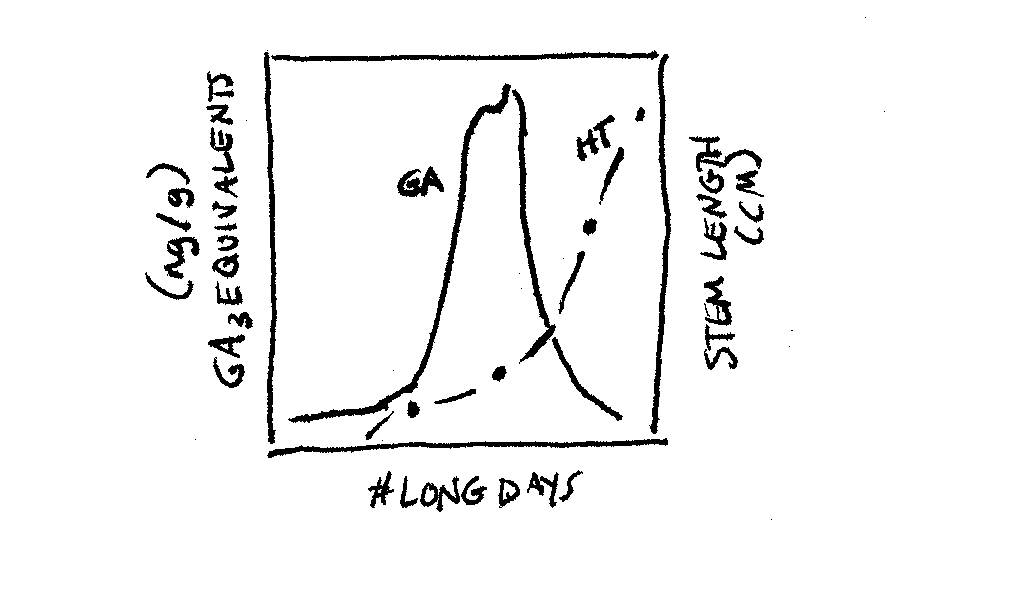 Introduction
to Organismal Biology (BIOL221) -
Dr.
S.G. Saupe; Biology Department, College of St. Benedict/St. John's
University, Collegeville, MN 56321; ssaupe@csbsju.edu;
http://www.employees.csbsju.edu/ssaupe/ Introduction
to Organismal Biology (BIOL221) -
Dr.
S.G. Saupe; Biology Department, College of St. Benedict/St. John's
University, Collegeville, MN 56321; ssaupe@csbsju.edu;
http://www.employees.csbsju.edu/ssaupe/ |
 Introduction
to Organismal Biology (BIOL221) -
Dr.
S.G. Saupe; Biology Department, College of St. Benedict/St. John's
University, Collegeville, MN 56321; ssaupe@csbsju.edu;
http://www.employees.csbsju.edu/ssaupe/ Introduction
to Organismal Biology (BIOL221) -
Dr.
S.G. Saupe; Biology Department, College of St. Benedict/St. John's
University, Collegeville, MN 56321; ssaupe@csbsju.edu;
http://www.employees.csbsju.edu/ssaupe/ |
Plant Hormones - The Experimental Evidence
I.
Case
Study: Phototropism and Coleoptiles.
The phototropic response of coleoptiles to the light has long
fascinated biologists. The following diagram show a summary of some of the
experiments that have been performed? List at least four conclusions that
can be made from these experiments.
II. Case Study: Soybeans and Fruit Set. Soybeans produce racemes of several flowers beneath a leaf (see diagram). Flowers were removed from some to investigate factors that influenced which pods set (mature seeds form inside) and which ones abort (fall off). The data are provided below. List at least three conclusions from these data.
Treatment Position 1 - 3 Position 6 - 8 none most set most abort remove flowers 1 - 3 --- most set remove flowers 1 - 3, add extract of these to their "holes" --- most abort
III.
Case Study - Proof that a
chemical is the hormone responsible for a certain developmental change.
Proving that a particular substance is a hormone is not
easy. Typically, a target tissue is treated with the suspected
hormone. If it causes a response, then the chemical is assumed to be
responsible for the phenomena. However, to be certain that a chemical is
involved:
Exogenous applications of the chemical to the target tissue bring about the developmental change
Lowering the endogenous levels of that chemical (using chemicals or genetic manipulation) prevents the developmental change from occurring under conditions that would normally bring about the change.
If the endogenous levels are lowered, adding the chemical exogenously will cause the developmental change
During normal development, the endogenous levels of that chemical rise in the appropriate tissue before the developmental effect is observed.
This case study involves corn-cockle (Agrostemma githago), a weedy plant that "bolts" when it flowers. In other words, it produces a flowering stem that rapidly elongates. Corn-cockle only bolts/flowers under long day (LD) conditions. Which hormone(s) is involved in this rapid growth response? Jones and Zeevaart (1980) hypothesized that gibberellic acid (GA) causes the bolting response. They grew corn-cockle under long day (LD) and short day (SD) treatments. Some plants were treated with GA20, one of the gibberellins. Other plants were also treated with with a GA synthesis inhibitor, Amo-1618. Their data are summarized below. Stem length was measured 25 days after the first long day. GA was applied six times, every other day, 1.2 μl.
| Treatment | Stem Length (cm) |
| SD | 2.2 |
| SD + GA20 | 11.2 |
| SD + GA20 + Amo-1618 | 10.2 |
| LD | 36.7 |
| LD + Amo-1618 | 2.9 |
| LD + GA20 + Amo-1618 | 30.2 |
They also measured GA levels and stem height for several days after long day
treatment. Their data are reproduced below:

Analysis: Study the data/experiment. Do these data suggest that GA is involved in bolting in corn-cockle? To support your answer, cite data for each of the four criteria for proving a chemical is a hormone.
- Which data show that exogenous application of hormone stimulates the response? Be specific.
- Which data show that reducing the endogenous levels of hormone prevents the response? Be specific.
- Which data show that reducing the endogenous levels and adding back the hormone exogenously restores the response?
- Which data show that the hormone levels appear and peak before the response?
Reference:
| | Top| SGS Home | CSB/SJU Home | Biology Dept | Biol221 Home | Disclaimer | |
Last updated: April 04, 2007 � Copyright by SG Saupe